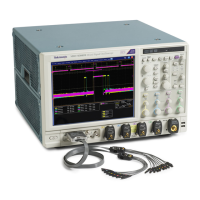Commands Listed in Alphabetical Order
ET sets the samp
ling mode to equivalent time allowed (ON in REPET).
The number of channels selected and the sampling speed affects the mode that
the instrumen
t uses to acquire data. At slow sampling speeds the instrument uses
real time sampling. At fast sampling speeds, the instrument uses equivalent time
sampling or interpolation. For speeds between these extremes, some instruments
create waveform records differently, depending on the number of input channels
selected.
Examples
ACQUIRE:SAMPLINGMODE IT specifies that interpolation is allowed.
ACQUIRE:SAMPLINGMODE? might return:ACQUIRE:SAMPLINGMODE RT,
indicating that sampling mode is real time only.
ACQuire:STATE
This command starts or stops acquisitions. When state is set to ON or RUN, a
new acquisition will be started. If the last acquisition was a single acquisition
sequence, a new single sequence acquisition will be started. If the last acquisition
was continuous, a new continuous acquisition will be started.
If RUN is issued in the middle of completing a single sequence acquisition (for
example, averaging or enveloping), the acquisition sequence is restarted, and
any accumulated data is discarded. Also, the instrument resets the number of
acquisitions. If the RUN argument is issued while in continuous mode, a reset
occurs and acquired data continues to acquire.
If acquire:stopafter is SEQUENCE, pressing the front panel RUN/STOP button is
equivalent to sending these commands:
ACQUIRE:STOPAFTER RUNSTOP and
either
ACQUIRE:STATE ON or A CQUIRE:STATE RUN.
Group
Acquisition
Syntax
ACQuire:STATE {OFF|ON|RUN|STOP|<NR1>}
ACQuire:STATE?
Related Commands
ACQuire:STOPAfter
Arguments
OFF stops acquisitions.
STOP stops acquisitions.
ON starts acquisitions.
RUN starts acquisitions.
DPO7000, DPO70000/B and DSA7000/B Series Programmer Manual 2-81

